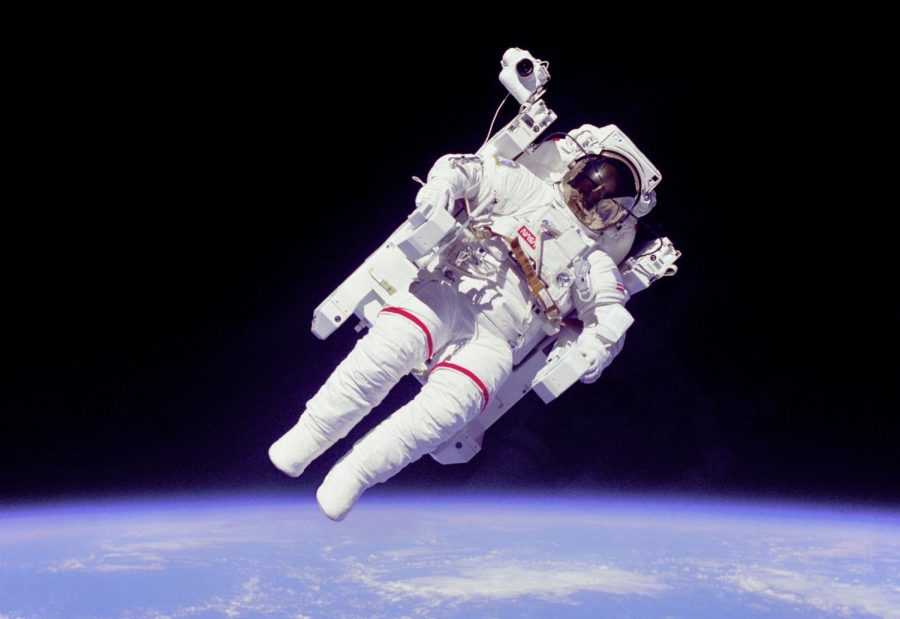Arnoldus: What NASA’s first fully-female spacewalk can teach us about gender inequality
NASA [Public domain], via Wikimedia Commons
Koch told the world, “This is a milestone. It symbolizes exploration by all that dare to dream and work hard to achieve that dream.”
October 24, 2019
NASA astronauts Christina Koch and Jessica Meir recently made history by executing the first fully-female spacewalk. The spacewalk lasted five and a half hours and was spent doing maintenance repairs on the International Space Station (ISS). Koch told the world from space:
“This is a milestone. It symbolizes exploration by all that dare to dream and work hard to achieve that dream.”
Surprisingly, some people don’t see this as a momentous occasion. In fact, they wish gender was left out of the headlines completely.
These are some of the comments left under NASA’s video on the all-female spacewalk:
- [@Snax]: “I didn’t like this ‘all-female’ advertisement. It’s a spacewalk, not a female spacewalk, the same as they are astronauts, not ‘female astronauts.’”
- [@drunk astronaut]: “The fact that anyone sees this as relevant makes me sad.”
- [@Giovanni Spagnuolo]: “This is not going to be remembered by anyone, sorry.”
While I love freedom of speech, comments like these make me worry about the people manning the keyboards. This raises some important questions: Why is it important to advertise this spacewalk as the first all-female spacewalk and not just another maintenance repair? Why is gender important in science? And most of all, why did this historical milestone take so long to happen?
For example, let’s talk about the reason it took so long for us to achieve a fully-female spacewalk. The spacesuits that astronauts wear today were made to fit men, not women. I highly recommend reading the Atlantic’s article, The Original Sin of NASA Space Suits, which details the causes and effects of androcentric space suits.
This outerwear issue is one that should have been fixed a long time ago, especially since we now know that women are sometimes better suited for spaceflight than men. Jim Bridenstine, a NASA administrator, commented that “Cranial pressure for women seems to be less than that of men when you’re in a microgravity environment for long periods of time.”
I plan to major in astrophysics and hope to work at an institution like NASA one day. My mother, a computer science major, raised me with the mindset that I could do anything, being an astronaut included. As I grew older, the odds that were stacked against me and the long, difficult road paved in math, lab reports and study sessions became more and more apparent. I didn’t see many girls around me planning to major in STEM fields and certainly didn’t see any girls planning to major in astrophysics, aerospace or physics.
Watching the movie Hidden Figures was my first major exposure to women of color role models in astrophysics. Seeing historical female trailblazers that were living my dream wasn’t just a relief; it was an inspiration. Movies like this are so crucial in showing kids that the traditional image of an engineer, mathematician, astronaut, etc. was made to be challenged.
For many young women, this spacewalk may be the first time they see someone who looks like them in the field they dream of pursuing. The following is an excerpt from an article Forbes magazine published on this topic:
“Female students who now enter the field are met with a sea of white men, limiting the opportunity for women to feel represented by people who can relate to their experiences. Having a research advisor or an instructor who looks like you and has had similar life experiences to you is an immense privilege, and one that not many women get to have in astronomy.”
In my junior year of high school, I started doing research at Mississippi State University’s aerospace engineering department, specifically the Raspet Flight Research Laboratory. I studied under a mentor who was a woman of color. She was the only woman in the lab, and during my two semesters (seventy hours) of research there, I got a glimpse of what it would be like to work as a woman in a STEM field.
I remember my mentor telling me I would have to work twice as hard as my male counterparts to be afforded the same respect, but I know that if I do, the women after me will have to work a little less. The Forbes article presented scary facts about the reality of STEM fields for women:
“Probably the most significant factor is outright sexism and gender-based/sexual harassment. Most women I know in astronomy can, if they wish, recount multiple stories of being sexually harassed by colleagues or advisors. A friend of mine once told me that she had been either harassed or assaulted by two male advisors and something like four male graduate students during her time in academia. Does that sound like an environment that can attract and retain women?”
When I asked my mentor if I should pursue my dream of working at NASA, she told me it was possible because she used to work at NASA. She also pointed out the fact that all my reasons for not wanting to major in astrophysics centered around the fact that people had told me I “seem more like an English person” or that I was doing slightly worse in my math classes compared to my male counterparts (although I was taking on many more extracurriculars), and my own self doubt–all patriarchy-endorsed reasons. I was lucky enough to have a female mentor who told me that I can achieve my dreams, but not every girl is.
The more I learn about the setbacks for women in STEM, the more intrigued I get and the more parallels I see in my own life. I decided to interview two female MSMS students who are interested in STEM careers and our female physics teacher who did her graduate dissertation on women in STEM.
Senior Bertha Mireles plans to major in a STEM field, most likely a double major in chemical and biomedical engineering or chemical engineering with a minor in computer science. Mireles says she has “been interested in working at big companies like Dell [or] Microsoft.”
Mireles recounts experiences her mom had when trying to get jobs at chemical plants in Mexico. She said, “A lot of the jobs that she got rejected from were the field jobs at chemical plants where you’re actually going up into the equipment and taking measurements and fixing all of that by hand, and that was seen as a man’s job.” Mireles said her mother was told, “You’re not a man, you’re a woman, and this is a man’s job, so we can’t accept you.” Mireles also described a time when her mother was looking for job offers on LinkedIn in Mexico where the job descriptions included the requirement of being a man. Mireles has also experienced self doubt because of her grades and comparison.
Junior Emily Berry, who wants to major in computer science and become a software engineer for a company like Google, discusses some of the factors that contribute to self doubt. Berry said that people don’t typically view her as a “STEM person.” When I asked about her learning environment she told me, “I’m the only female in my programming class.” Mireles had the same experience in her Intro to Programming class last year. Berry said that the odds stacked against her as a female only motivate her to work harder.
I wanted to know more about the factors that cause women to be discouraged from STEM and what we can do about them, so I interviewed Dr. Grimes, our female physics teacher who did her graduate dissertation on women in STEM. Grimes said the following about the first fully-female spacewalk:
“Space and STEM fields have been dominated by men for so long that having a concentrated effort to put women into space…is incredibly important to boosting the attitudes of women who want to go into STEM.”
Grimes also remarked on the significance of advertising the spacewalk as female:
“If you look into the history for long enough you find that there have been women in it all along, they were just behind closed doors, so now to make it public is an amazing thing to see happen.”
For this reason, it is important that NASA’s first all-woman spacewalk was advertised as such. Equal gender representation in media dealing with STEM is important because STEM fields have not yet reached gender equality. A role model can make all the difference in catalyzing the confidence of young women interested in STEM. Grimes seconds this by saying, “It [female role models in STEM] is incredibly important. They’ve actually shown that having a role model, having someone that looks like you within a certain sphere, can actually boost your motivation and your confidence in a field.”
I asked Grimes what we individually can do to encourage women towards STEM. She insightfully responded that we should remind them that they can and should go into STEM even if they don’t fit the stereotype. Her response is coherent with the experiences of the women I interviewed for this article, myself, and countless other women who have been told because of their gender that they don’t “look like a STEM person.”
“What happens oftentimes for women in engineering, because they’re already dealing with a conflict with their identity, [is] that they really see themselves as a girly girl but they want to go into this field, but they keep being told these things of how they don’t look like an engineer, they don’t act like an engineer. Then they fail a test, and maybe everyone failed the test, but because they have all of these little extra burdens, when they fail the test it plummets their confidence.”
Gender stereotypes are harmful beyond just hurt feelings. We as a society are disenfranchising half of our population and pushing them towards lower-paying jobs, harmful perfectionism, and submissive societal roles.
For all these reasons, the world’s first fully-female spacewalk is a historical landmark, another rung on the ladder to gender equality, and should be treated as such. Chelsea Gohd, a writer for Space.com, published an article about the spacewalk. She sums up the event perfectly, calling it “One giant leap for womankind.”










